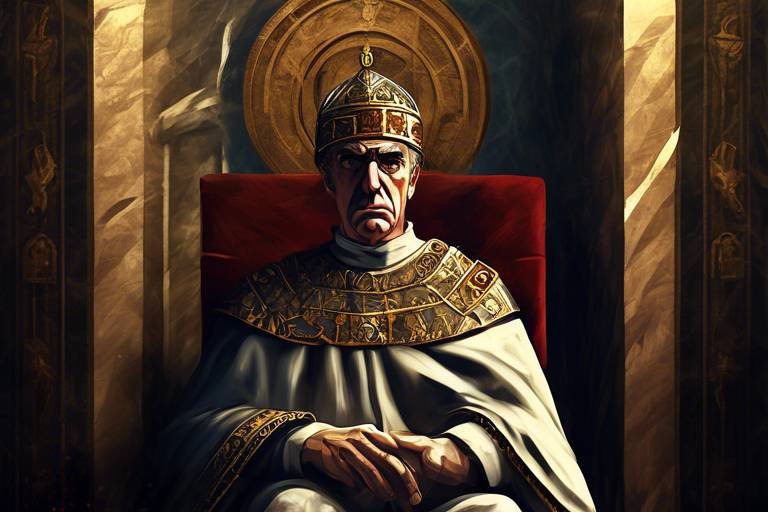Ramses II: The Great Egyptian Pharaoh
Ramses II, also known as Ramesses the Great, was a legendary Egyptian pharaoh who reigned for over six decades, leaving an indelible mark on the history and culture of ancient Egypt. His rule was characterized by military conquests, grand architectural projects, and significant contributions to religion and art.
From his early years, Ramses II showed great promise, eventually ascending to the throne at a young age. His upbringing and family background played a crucial role in shaping his leadership qualities and vision for the Egyptian empire. As pharaoh, he embarked on numerous military campaigns, expanding the kingdom's borders through strategic battles and conquests.
One of Ramses II's most enduring legacies lies in his architectural achievements. He commissioned awe-inspiring temples and monuments, such as the iconic Abu Simbel temples and the majestic Ramesseum, showcasing his dedication to the gods and his desire to leave a lasting imprint on the landscape of Egypt.
Deeply rooted in religious beliefs, Ramses II was a patron of various deities, influencing the cultural and artistic landscape of ancient Egypt. His support for literature, art, and religious practices enriched the kingdom's heritage and left a lasting impact on future generations.
Despite his royal status, Ramses II valued his family deeply. With multiple wives, children, and descendants, he established a powerful dynasty that shaped the future of Egypt for generations to come. His personal life and dynastic ambitions offer a glimpse into the complexities of pharaonic rule.
Following his death, Ramses II's legacy endured through the ages, solidifying his place as a symbol of Egyptian power and glory. Depicted in ancient texts and modern media, his image continues to captivate scholars and enthusiasts alike, embodying the grandeur of Egypt's golden age.
The passing of Ramses II marked the end of an era in Egyptian history, leading to a period of transition and decline known as the New Kingdom's twilight. Despite the challenges that followed, his influence persisted, shaping the course of events in the ancient world.
Recent archaeological discoveries and ongoing research efforts have shed new light on Ramses II's life and reign, offering fresh perspectives on his accomplishments and reign. These findings continue to shape our understanding of this legendary pharaoh, revealing the depth of his impact on Egyptian history.

Early Life and Ascension to the Throne
Exploring the life, reign, and legacy of Ramses II, one of ancient Egypt's most renowned pharaohs who ruled for over 60 years and left a lasting impact on Egyptian history and culture.
Ramses II, born in 1303 BC, was the son of Seti I and Queen Tuya. His early life was surrounded by luxury and education in the royal court of Egypt. As a young prince, Ramses II received military training and was groomed for kingship. At the age of 25, he ascended to the throne after the death of his father, Seti I. His quick rise to power was a result of his father's careful preparation and the strong support of the Egyptian nobility.

Military Campaigns and Expansion
Ramses II, known as the Great Egyptian Pharaoh, was not only a remarkable ruler but also a formidable military leader. His military campaigns and expansion efforts were pivotal in shaping the Egyptian empire during his reign. Ramses II's thirst for conquest and desire to expand Egypt's borders knew no bounds, leading to numerous battles and territorial acquisitions that solidified his reputation as a warrior pharaoh.
One of the most famous military campaigns led by Ramses II was the Battle of Kadesh, fought against the Hittite Empire. This epic clash, immortalized in inscriptions and reliefs, showcased Ramses II's strategic acumen and military prowess. Despite facing a formidable enemy, Ramses II managed to secure a favorable outcome, demonstrating his skill in warfare and leadership on the battlefield.
Through a series of military expeditions, Ramses II expanded Egypt's influence across the Near East, establishing Egyptian control over strategic territories and trade routes. His conquests extended into modern-day Syria and Nubia, enriching the Egyptian empire and bolstering its economic and political power.
Ramses II's military campaigns were not only about territorial expansion but also about projecting Egyptian strength and prestige. The pharaoh's victories were celebrated through grandiose monuments and inscriptions, glorifying his achievements and immortalizing his legacy for future generations to admire.
Moreover, Ramses II's military successes were instrumental in maintaining stability and security within the Egyptian realm. By quelling rebellions and securing the borders, he ensured the prosperity and longevity of his reign, earning him the title of the "Great Ancestor" among his subjects.
In conclusion, Ramses II's military campaigns and expansion efforts were integral to his legacy as one of Egypt's most renowned pharaohs. His conquests, battles, and strategic maneuvers not only expanded the Egyptian empire but also solidified his reputation as a legendary warrior king whose legacy continues to captivate historians and enthusiasts alike.

Architectural Achievements
Ramses II, also known as Ramses the Great, was not only a formidable ruler but also a prolific builder, leaving behind a legacy of architectural marvels that continue to awe and inspire to this day. His architectural achievements stand as a testament to his grand vision and unwavering dedication to immortalizing his reign through monumental structures.
One of the most iconic monuments commissioned by Ramses II is the Abu Simbel temples, located in southern Egypt near the border with Sudan. These temples, carved into the rock face of a cliff, were dedicated to the deities Amun, Ra-Horakhty, and Ptah, as well as to Ramses himself. The colossal statues of Ramses II flanking the entrance to the main temple are a striking example of ancient Egyptian artistry and engineering prowess.
In addition to Abu Simbel, Ramses II also oversaw the construction of the Ramesseum, a vast mortuary temple complex located on the west bank of the Nile in Thebes. The Ramesseum served as a place of worship and commemoration for the pharaoh and featured elaborate reliefs depicting his military victories and divine connections. The sheer scale and intricacy of the Ramesseum reflect Ramses II's desire to leave a lasting mark on the Egyptian landscape.
Ramses II's architectural achievements were not limited to temples and mortuary complexes. He also embarked on ambitious building projects in the city of Pi-Ramesses, his new capital in the Nile Delta. The city featured grand palaces, administrative buildings, and infrastructure developments, showcasing Ramses II's commitment to urban planning and governance.
Moreover, Ramses II's influence extended beyond Egypt's borders, as evidenced by the construction of the city of Qantir in the eastern Delta, which served as a strategic military and administrative center. The architectural remains at Qantir provide valuable insights into the extent of Ramses II's territorial control and his efforts to consolidate power in the region.
Overall, Ramses II's architectural achievements epitomize the grandeur and splendor of ancient Egyptian civilization, reflecting his enduring legacy as a visionary leader and a master builder. The monumental structures he commissioned continue to fascinate historians, archaeologists, and visitors alike, offering a glimpse into the opulence and sophistication of the New Kingdom era.

Religious Beliefs and Cultural Contributions
Ramses II, known for his military prowess and architectural achievements, was also deeply invested in religious beliefs and cultural contributions that shaped ancient Egypt's spiritual landscape. His reign was marked by a strong devotion to various deities, with Amun-Ra being one of the most prominent gods he worshipped. This patronage extended to the construction of magnificent temples dedicated to these gods, such as the awe-inspiring structures at Abu Simbel and the Ramesseum.
Furthermore, Ramses II's cultural contributions extended beyond religious practices. He was a prolific builder and a patron of the arts, fostering a flourishing period of Egyptian literature, art, and architecture. The pharaoh's support for these cultural endeavors not only enriched the artistic landscape of ancient Egypt but also solidified his legacy as a great benefactor of the arts.
One of the most notable aspects of Ramses II's religious beliefs was his association with the concept of divine kingship. He saw himself as a divine ruler, a living god on earth, embodying the will of the gods and ensuring the prosperity of his kingdom. This belief system not only elevated the pharaoh's status in the eyes of his subjects but also reinforced the religious and political structures of ancient Egypt.
Moreover, Ramses II's cultural contributions were not limited to his own reign but had a lasting impact on subsequent generations. His architectural marvels, religious practices, and artistic patronage influenced the development of Egyptian culture for centuries to come, leaving an indelible mark on the country's artistic and religious traditions.
In conclusion, Ramses II's religious beliefs and cultural contributions were integral to his legacy as one of ancient Egypt's most revered pharaohs. His devotion to the gods, support for the arts, and promotion of divine kingship set him apart as a ruler who not only expanded Egypt's empire but also enriched its spiritual and cultural heritage.

Family and Personal Life
Exploring Ramses II's family and personal life provides a glimpse into the intricate web of relationships that characterized the pharaoh's reign. Ramses II was known for his extensive royal family, which included numerous wives, children, and descendants. His primary wife and queen was Nefertari, who held a significant position in his court and bore him several children, including his heir, Amun-her-khepeshef. Additionally, Ramses II had a harem of secondary wives and concubines, further expanding his familial connections.
One of the most notable aspects of Ramses II's family life was his strategic approach to dynastic succession. By marrying into powerful royal families and appointing his sons to key positions within the government and military, Ramses II ensured the continuity of his lineage and the stability of his rule. This calculated approach to family and succession planning was a hallmark of his reign and contributed to the longevity of the New Kingdom era.
Despite his political acumen and strategic marriages, Ramses II also had a softer, more personal side that is revealed through his depictions in art and inscriptions. Images of the pharaoh with his children and grandchildren adorn temple walls, showcasing a familial bond that transcended his role as a ruler. These intimate portrayals offer a rare glimpse into Ramses II's personal life and the affection he held for his family members.
Moreover, Ramses II's family connections extended beyond the borders of Egypt, as he forged diplomatic alliances through marriage with foreign princesses from neighboring kingdoms. These international marriages not only solidified political ties but also enriched the cultural exchange between Egypt and its allies, demonstrating Ramses II's ability to leverage familial relationships for diplomatic gain.
In essence, Ramses II's family and personal life were intricately intertwined with his political ambitions and legacy as a pharaoh. The complex network of relationships he cultivated, both within Egypt and beyond, underscored the importance of kinship and lineage in ancient Egyptian society, shaping the course of history for generations to come.

Legacy and Historical Impact
After his death, Ramses II left behind a legacy that reverberated through the annals of Egyptian history. Known as Ramses the Great, he was immortalized not only for his military conquests but also for his architectural achievements and cultural contributions that shaped the Egyptian civilization for centuries to come. His reign marked a golden age in Egypt, characterized by prosperity, grandeur, and power.
One of Ramses II's most significant historical impacts was his portrayal in ancient texts and inscriptions. He was depicted as a powerful and revered pharaoh, a divine ruler chosen by the gods to lead Egypt to greatness. His image adorned temples, statues, and monuments, symbolizing strength, wisdom, and eternal life. The tales of his military victories and building projects were inscribed on the walls of temples and tombs, ensuring that his name would endure throughout the ages.
Moreover, Ramses II's legacy transcended ancient times and continued to influence modern perceptions of Egyptian history. His reputation as a formidable leader and skilled warrior inspired admiration and fascination among scholars, historians, and enthusiasts worldwide. In contemporary media, Ramses II is often portrayed as the epitome of Egyptian power and glory, a symbol of the country's rich heritage and cultural legacy.
Furthermore, the historical impact of Ramses II extended beyond Egypt's borders, influencing neighboring civilizations and shaping diplomatic relations in the ancient world. His military campaigns and alliances with foreign powers solidified Egypt's dominance in the region, establishing a legacy of imperial ambition and strategic prowess that resonated throughout the Near East.
In conclusion, Ramses II's legacy and historical impact are undeniable, leaving an indelible mark on Egyptian history and culture. His reign as pharaoh was a testament to his enduring influence, shaping the course of ancient Egypt and inspiring generations to come.

Death and Aftermath
After a long and illustrious reign, the inevitable moment arrived for Ramses II, the great Egyptian pharaoh, as he faced his own mortality. The death of Ramses II marked the end of an era in ancient Egypt, triggering a series of events that would shape the course of history in the region.
Following his passing, Egypt plunged into a period of uncertainty and transition. The loss of such a powerful and revered leader left a void in the hearts of the Egyptian people and created a power vacuum at the highest levels of authority. The succession of the throne became a matter of intense political intrigue and competition among the pharaoh's descendants and court officials.
Amidst the struggle for power, the once mighty New Kingdom began to show signs of weakness and decline. The empire that Ramses II had worked so tirelessly to expand and fortify started to fragment, facing external threats and internal strife. The stability and grandeur that characterized his rule seemed to fade away, giving rise to a period of uncertainty and vulnerability for Egypt.
As the dust settled on Ramses II's legacy, his monuments and achievements stood as a testament to his greatness and ambition. The grand temples, statues, and inscriptions he commissioned served as a reminder of his enduring influence on Egyptian culture and history. However, the world he had known and shaped was rapidly changing, paving the way for new rulers and dynasties to leave their mark on the land of the pharaohs.
The death of Ramses II marked not only the end of a chapter in Egyptian history but also the beginning of a new era filled with challenges and opportunities. The legacy of the great pharaoh lived on in the hearts and minds of the Egyptian people, inspiring future generations to strive for greatness and uphold the traditions of their ancestors.

Modern Discoveries and Research
In recent years, archaeological excavations and scientific studies have shed new light on the life and reign of Ramses II, uncovering fascinating details about this legendary pharaoh. One significant discovery was the identification of Ramses II's mummy, which provided valuable insights into his health, physical appearance, and possible causes of death. Researchers have also unearthed ancient texts and inscriptions that offer fresh perspectives on Ramses II's military campaigns, architectural projects, and religious beliefs.
Moreover, ongoing research efforts have utilized advanced technologies such as 3D scanning and DNA analysis to further explore Ramses II's lineage, familial relationships, and genetic predispositions. These scientific breakthroughs have enabled historians to piece together a more comprehensive picture of the pharaoh's family tree and dynastic connections. Additionally, interdisciplinary studies combining archaeology, anthropology, and Egyptology have deepened our understanding of the political, social, and cultural context in which Ramses II ruled.
Furthermore, collaborative projects between international teams of experts have facilitated the preservation and restoration of Ramses II's monumental structures, ensuring that future generations can continue to marvel at the architectural marvels he commissioned. The meticulous documentation of inscriptions, reliefs, and artifacts found in temples and tombs associated with Ramses II has provided valuable data for scholars and researchers studying ancient Egyptian history and art.
Overall, the ongoing exploration of Ramses II's legacy through modern discoveries and research endeavors underscores the enduring fascination with this iconic pharaoh and the importance of continuing to unravel the mysteries of ancient Egypt's past.
Frequently Asked Questions
- 1. Who was Ramses II?
Ramses II, also known as Ramses the Great, was a prominent pharaoh of ancient Egypt who reigned for over 60 years during the 19th dynasty. He is renowned for his military campaigns, architectural achievements, and cultural contributions.
- 2. What were Ramses II's major accomplishments?
Ramses II's major accomplishments include expanding the Egyptian empire through military conquests, constructing grand temples and monuments, fostering artistic and cultural developments, and leaving a lasting legacy in Egyptian history.
- 3. How many wives and children did Ramses II have?
Ramses II is believed to have had numerous wives, with estimates ranging from 8 to over 100. He fathered over 100 children, including his successors and prominent figures in Egyptian history.
- 4. What is the significance of Ramses II in Egyptian history?
Ramses II is considered one of the greatest pharaohs in Egyptian history, known for his military prowess, architectural achievements, and cultural influence. His reign marked a period of prosperity and power for ancient Egypt.
- 5. How has modern research contributed to our understanding of Ramses II?
Modern archaeological discoveries and scientific studies have provided new insights into Ramses II's life and reign, shedding light on his accomplishments, family life, and the historical context of ancient Egypt during his rule.



















